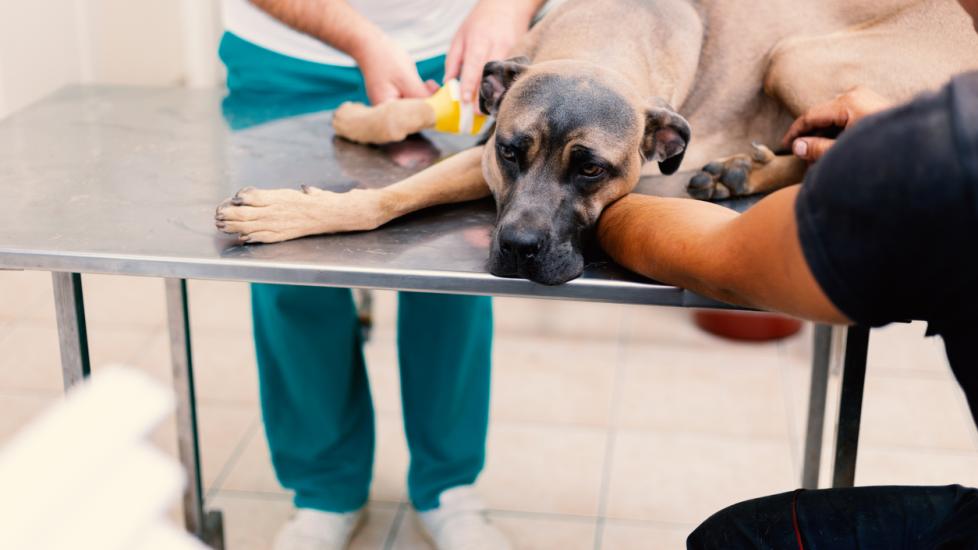Shock in Dogs
What Causes Shock in Dogs?
Shock is a complex, whole-body reaction to various situations, typically caused by a lack of effective circulation, decreased oxygen, and/or decreased energy usage within cells. If your pet is not treated quickly, shock is usually fatal.
The term “shock” has different meanings, even among specialists. In general, it is characterized by the following types and their causes:
-
Hypovolemic shock, the most common type, occurs when the circulating blood volume is dangerously low. This happens with internal hemorrhage (ruptured tumors), external hemorrhage (trauma), coagulopathies (impairment of blood clotting ability), low blood protein, or dehydration (vomiting and diarrhea, burns, or decreased drinking).
-
Cardiogenic shock is a severe form of heart failure, where the heart cannot properly pump blood throughout the body. It occurs due to heart disease, heartworm infection, toxins, drug reactions, or severe arrhythmias.
-
Distributive shock, also known as vasodilatory shock, occurs when there is an incorrect distribution of blood flow. This type of shock includes the more well-known subtypes: septic (due to infection of the bloodstream, commonly caused by bacterial infection) and anaphylactic (due to allergic response). It is caused by a variety of abnormalities, generally associated with too much blood volume in the peripheral tissues and not enough circulating in the main vessels. Systemic inflammatory response syndrome (SIRS), adverse drug reactions, drug overdose, heatstroke, and embolic disease are other causes of distributive shock.
-
Hypoxic shock is caused by decreased blood oxygen levels. This may be secondary to lung disease or to the blood’s inability to carry oxygen correctly. Examples of diseases leading to hypoxic shock include methemoglobinemia, carbon monoxide toxicity, severe lung disease, and anemia.
-
Metabolic shock occurs when the tissues have good blood and oxygen supply but the cells can’t produce enough energy to stay alive. It is caused by abnormal cell metabolism and occurs in some cases of sepsis, low blood sugar, cyanide toxicity, pH abnormalities, and mitochondrial dysfunction.
Because of the complexity of shock, animals will often have multiple types of shock at the same time. For example, a dog in septic shock may also have a degree of hypovolemic shock. In other cases, one type of shock may lead to another as organs fail.
Shock in any form is a medical emergency. Seek emergency veterinary care immediately if you think your dog is showing signs of shock.
Health Tools
Not sure whether to see a vet?
Symptoms of Shock in Dogs
Dogs in shock may have a history of trauma, surgery, weakness, collapse, vomiting, diarrhea, or decreased water intake.
Signs of shock include:
-
Pale or discolored gums
-
Weak pulses
-
Altered, dull mental state, such as lethargy or confusion
-
Decreased body temperature
-
Increased and abnormal heart rate
-
Difficulty breathing
-
Dehydration (presenting as decreased skin elasticity, tacky mucous membranes, sunken eyes)
Stages of Shock in Dogs
The signs of shock continuously change and progress quickly. In the early, or compensated, stage of shock, some animals only show mild clinical signs. This early stage can be difficult to recognize, but as time passes, shock can progress to an intermediate stage, known as early decompensated shock.
In the intermediate stage, the body attempts to conserve blood volume and proper cardiac output by giving vital organs priority in blood distribution. Often, this attempt reduces blood to the other organs, causing them to fail. Without intervention and veterinary treatment, dogs will die once they have reached the intermediate stage.
The late stage of shock, also known as late decompensated or irreversible shock, leads to systemic inflammation, systemic organ failure, and death. Survival after this stage of shock is rare.
How Veterinarians Diagnose Shock in Dogs
Veterinarians may suspect shock based on a physical exam and the dog’s history. All types of shock will require similar testing. The common tests include:
-
Routine bloodwork, including a complete blood count and biochemistry profile, to look for secondary issues and organ function
-
Lactic acid tests that indicate how successfully the blood is being distributed to the body
-
Blood gas and oxygen saturation (SpO2) analyses to assess oxygenation status
-
Blood pressure evaluation
-
Electrocardiogram (ECG or EKG) to monitor arrhythmias
-
Radiographs to assess for internal hemorrhage, wounds, cancer, heart or lung disease
-
Coagulation tests to determine a potential cause of shock or the severity of shock
-
Checking for cardiac enzymes that may indicate heart muscle injury
-
Echocardiography (heart ultrasound) to assess for cardiac dysfunction, valve disease, contractility, and heartworm
Treatment of Shock in Dogs
Regardless of the type of shock, the goals for treating dogs in shock are the same: to minimize the pet’s stress as much as possible, to diagnose and treat the underlying disease processes, and to:
-
Restore blood volume with intravenous fluids* and blood transfusions if needed
-
Stop any ongoing hemorrhage or damage
-
Increase tissue oxygenation with supplemental oxygenation
-
Correct any cardiac arrhythmias with drugs or surgery
-
Prevent (or treat) any potential infection or suspicion of sepsis with broad-spectrum antibiotic therapy
-
Prevent and correct any organ failure
*Intravenous fluids are crucial; however, in cardiogenic shock, this treatment could make the situation worse until the underlying condition is corrected
Recovery and Management of Shock in Dogs
When left untreated, shock normally results in death. Early recognition, diagnosis of underlying disease, aggressive treatment, and ongoing monitoring are essential for a good outcome.
The following interventions are required during the recovery process:
-
Serial testing of organ function, cardiac status, blood pressure, and oxygenation levels
-
Physical exams
-
Monitoring of vital signs (temperature, heart rate, respiratory rate)
Once vital signs, blood pressure, and urine output have returned to normal, most dogs are out of severe crisis. However, these patients are still in critical condition and will likely need prolonged hospitalization.
References
Help us make PetMD better
Was this article helpful?
